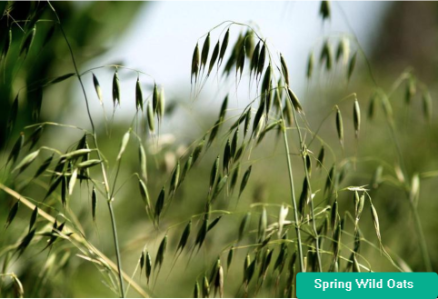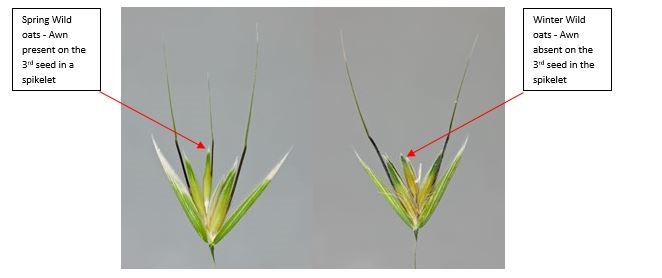Wild Oats
There are two types of wild oats – spring (Avena fatua) and winter (Avena sterilis). Spring wild oats are the most common type in Irish tillage soils. Occasionally, fields can have a mix of spring and winter wild oats.
Avena Fatua (Spring Wild Oats)
- Awns are present on the third seed within the spikelet.
- Seeds separate when mature and shed singly.

Figure 1. Spring Wild Oats
Avenua Sterilis (Winter Wild Oats)
- Awns are absent on the third seed in a spikelet.
- Seeds remain attached when mature and shed as a unit.
Spring Wild Oats: Key Features
- A population of 1 plant per m2 has the potential to cause a yield loss of 1%.
- Predominately spring germinating, but sporadic and unpredictable emergence patterns (i.e. a proportion of seedling may germinate between September and May and complicates control options).
- Seeds can survive in soil for several years and are therefore unaffected by seed burial depth.
- Light promotes seed germination.
- Most seeds emerge from the top 10 cm of soil, but some emerge from greater depths (15 to 25 cm).
- It flowers from June onwards and sheds seed from July.
A single well-tillered plant can produce up to 200 seeds.
Scorecard Wild Oats (pdf)
Spring Wild Oats: Identification
- Leaf blades twisted anti-clockwise, which is apparent even at the 2-4 leaf stage.
- Fine hairs along the edge of the leaf blade and sheath.
- Ligule long (6-8 mm) and serrated.
- Loose drooping panicle.
- Leaves rolled in shoot.
 Figure 2. Spring Wild Oats Identification
Figure 2. Spring Wild Oats Identification

Figure 3. Spring Wild Oats vs Winter Wild Oats
